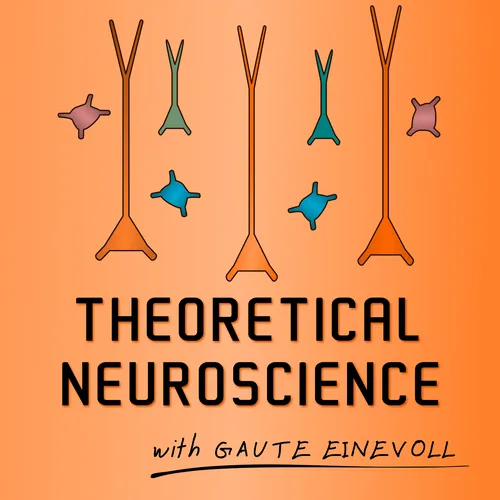
Theoretical Neuroscience Podcast
The podcast focuses on topics in theoretical/computational neuroscience and is primarily aimed at students and researchers in the field.
- Update frequency
- every 22 days
- Average duration
- 96 minutes
- Episodes
- 31
- Years Active
- 2023 - 2025

On how to cure brain diseases - with Nicole Rust - #31
A promise of basic neuroscience research is that the new insights will lead to new cures for brain diseases. But has that happened so far?
Today’s guest, an accomplished professor of neuroscience, de…

On co-dependent excitatory and inhibitory plasticity - with Tim Vogels - #30
Synaptic plasticity underlies several key brain functions including learning, information filtering and homeostatic regulation of overall neural activity.
While several mathematical rules have been d…

On the philosophy of simplification in computational neuroscience - with Mazviita Chirimuuta and Terrence Sejnowski - #29
Computational neuroscientists rely on simplification when they make their models. But what is the right level of simplification?
When should we, for example, use a biophysically detailed model and wh…

On whole-cell modeling of bacteria - with Markus Covert - #28
A future computational neuroscience project could be to model not only the signal processing properties of neurons, but also all processes that keep a neuron alive for, say, a 100-year life span.
In …

On construction and clinical use of multipurpose neuron models - with Etay Hay - #27
Numerous neuron models have been made, but most of them are "single-purpose" in that they are made to address a single scientific question. In contrast, multipurpose neuron models are made to be used…

On the population code in visual cortex - with Kenneth Harris - #26
With modern electrical and optical measurement techniques, we can now measure neural activity in hundreds or thousands of neurons simultaneously. This allows for the investigation of population codes…

On growing synthetic dendrites – with Hermann Cuntz - #25
The observed variety of dendritic structures in the brains is striking. Why are they so different, and what determine the branching patterns?
Following the dictum “if you understand it, you can build…

On neuroscience foundation models - with Andreas Tolias - #24
The term “foundation model” refers to machine learning models that are trained on vast datasets and can be applied to a wide range of situations. The large language model GPT-4 is an example.
The gro…

On human whole-brain models - with Viktor Jirsa - #23
A holy grail of the multiscale approach for physical brain modelling is to link the different scales from molecules, via cells and local neural networks, up to whole-brain models.
The goal of the Vir…

On 40 years with the Hopfield network model - with Wulfram Gerstner - #22
In 1982 John Hopfield published the paper "Neural networks and physical systems with emergent collective computational abilities" describing a simple network model functioning as an associative and c…

On models for short-term memory - with Pawel Herman - #21
The leading theory for learning and memorization in the brain is that learning is provided by synaptic learning rules and memories stored in synaptic weights between neurons.
But this is for long-ter…

On neuro-AI on the boat - part 2 of 2 - with Cristina Savin, Tim Vogels, Mikkel Lepperød, Paul Middlebrooks - #20
In September Paul Middlebrooks, the producer of the podcast BrainInspired, and I were both on a neuro-AI workshop on a coast liner cruising the Norwegian fjords.
We decided to make two joint podcasts…

On neuro-AI on the boat - part 1 of 2 - with Ken Harris, Andreas Tolias, Mikkel Lepperød, Paul Middlebrooks - #19
In September Paul Middlebrooks, the producer of the podcast BrainInspired, and I were both on a neuro-AI workshop on a coast liner cruising the Norwegian fjords.
We decided to make two joint podcasts…

On electric brain signals - solo episode - #18
Most of what we have learned about the functioning of the living brain has come from extracellular electrical recordings, like the measurement of spikes, LFP, ECoG and EEG signals.
And most analysis …

On dendritic function - with Yiota Poirazi - #17
The most prominent visual characteristic of neurons is their dendrites.
Even more than 100 years after their first observation by Cajal, their function is not fully understood. Biophysical modeling b…

On consciousness - with Christof Koch - #16
The greatest mystery of all is why a group of atoms, like the ones constituting me, can feel anything. The mind-brain problem has puzzled philosophers for millennia.
Thanks to pioneers like Christof…

On the simulation tool NEURON - with Michael Hines - #15
Computational neuroscientists use many software tools, and NEURON has become the leading tool for biophysical modeling of neurons and neural network.
Today’s guest has been the leading developer of N…

On the molecular memory code - with Sam Gershman - #14
The idea that memories are stored in molecules was popular in the middle of the 20th century. However, since the discovery of long-term potentiation (LTP) in the 1970s, the dominant view has been tha…

On quantum biology - with Johnjoe McFadden - #13
Is quantum physics important in determining how living systems, including brains, work?
Today's guest is a professor of molecular genetics at the University of Surrey in England and explores this qu…

On modeling of signaling pathways inside the neuron - with Avrama Blackwell - #12
Most computational neuroscientists investigate electric dynamics in neurons or neural networks, but there is also computations going on inside neurons.
Here the key dynamical variables are concentrat…